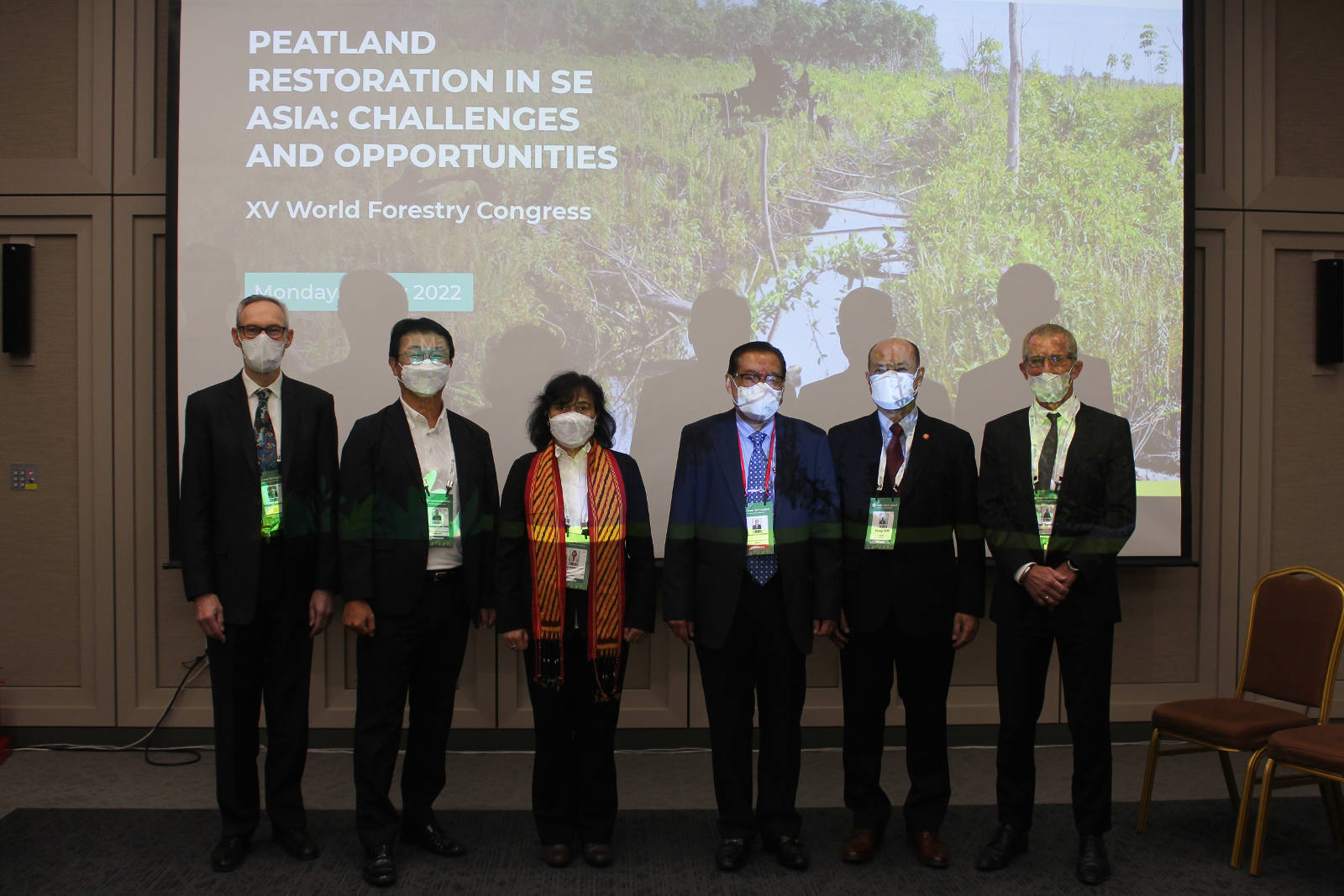
At the fifteenth World Forestry Congress (WFC) in Seoul, South Korea, the critical contributions of forests to climate-change mitigation, biodiversity, and livelihoods were top of mind. Tropical peatlands were particularly lauded for their outsize carbon sequestration potential, alongside their contributions to broader sustainable development goals.
But the ‘devil is in the details’, and questions remain about how to better support peatland restoration projects. In that context, the International Tropical Peatlands Centre (ITPC) chaired a session at the Congress, on 2 May 2022, focusing on challenges and opportunities for peatland restoration in South-East (SE) Asia.
The region is critical to questions of peatland restoration, as it contains around half of the world’s tropical peatlands, which collectively store an estimated 120 billion tons of carbon – approximately five percent of all global terrestrial carbon storage.
Yet nearly 80% of these peatlands have been deforested and drained. “Despite their importance in terms of environmental and economic services, tropical peatlands are amongst the most vulnerable ecosystems,” said Gandi Sulistyanto, Indonesian Ambassador to the Republic of Korea, who was reading out remarks by the Indonesian Minister for the Environment and Forestry, Siti Nurbaya. “Through anthropogenic activities, peatlands are subject to rapid degradation due to strong economic and social pressure on land for agriculture and plantations.”
These drained and degraded peatlands are particularly prone to wildfire, said Adam Gerrand, who is the Chief Technical Advisor for Indonesia’s REDD+ (reducing emissions from deforestation and forest degradation, and fostering conservation, sustainable management of forests, and enhancement of forest carbon stocks) program at the UN’s Food and Agriculture Organization (FAO). “It’s a vicious circle,” he said. “They then get land subsidence, which leads to flooding. In climate change terms, they then release significant greenhouse gas emissions from peat decomposition, and particularly when you get to fire, it can go down a lot more, so you’re losing valuable carbon stores from the top. When that happens, you get a reduced ability to provide ecosystem services – all those important values of carbon storage, biodiversity, and the productive ecosystem that supports local livelihoods, are damaged, and in many cases, extremely hard to repair.”
Vong Sok, the Head of the Environment Division, and Assistant Director of the Sustainable Development Directorate at the ASEAN Secretariat, spoke about the synergies between peatland restoration and haze management, and opportunities to work together on these issues through the ASEAN Agreement on Transboundary Haze Pollution. “Joining hands is important – this way, we can promote technical cooperation and scientific research to provide a robust solution for all: not only the public sector, but also the private sector and community.”
Kim Hyoung Gyun, Project Manager for the Korea-Indonesia Forest Cooperation Center, shared his organization’s experience and learnings from implementing a peatland restoration project in collaboration with local stakeholders in Jambi, Indonesia. “Even though our goal was the same [as the other stakeholders] – to restore the peatlands – the details were quite different,” he said. “Our management team realized that the goal of the project is not only to restore the peatlands, but to work together to restore the peatlands. We had a strong intention to drive the project in our own way, efficiently. Actually, though, we needed to make the journey together as a cooperative project partner: efficiency is important, but effectiveness is also critical.”
To that end, Haruni Krisnawati, the ITPC’s Lead Coordinator and moderator of the session, spoke about the importance of monitoring and adaptation in restoration projects. “Peatland restoration is a complex process that requires continuous monitoring to enable an adaptive, iterative landscape approach that meets local conditions and needs,” she said. “Restoration monitoring can inform our design strategy, site selection and management approach – as well as improve restoration outcomes through adjustment.”
Robert Nasi, CIFOR’s Director General, spoke about some of CIFOR’s work to create a framework of criteria and indicators to define and monitor the success – or otherwise – of peatland restoration projects. “What is missing now, and what we’d like to do, is really put it into action: how do we transform something that is a theoretical framework of criteria and indicators to something that could be a certification system, like FSC [Forest Stewardship Council] or PEFC [Programme for the Endorsement of Forest Certification].”
Brad Sanders, who is Head of Operations at the Riau Andalan Pulp and Paper Group (APRIL)’s ecosystem restoration project Restorasi Ekosistem Riau, shared some of his experiences with the private-sector-led effort, which seeks to restore degraded peatlands in the center of a ring of fiber plantations. He listed challenges such as the logistics of getting teams in to restore isolated areas; songbird poaching; and illegal logging, which the project aims to address through measures such as active security patrols and community agreements. He also cited key restoration work so far, which includes activities such as planting, rewetting, and biodiversity monitoring – including collaborating with the government to release a Sumatran tiger into the regenerating forest there.
The panellists also fielded questions from participants, and Krisnawati closed by reiterating the critical role of peatlands in the SE Asian economy, as well as their sensitivities to the impacts of human activities. “Strong efforts are urgently needed to protect, restore, and sustainably manage our peatlands,” she concluded.









